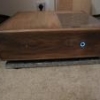Posted 14 October 2021 - 01:49 AM
Hello everybody. I have been carefully reading the evolutions of SSDs introduced in the audiophile market, but the changes were significant and, I confess, removed all my reference. To date, all SSDs I've tried worked better when using independent power supply and SATA connection with a better quality cable. The NVMe SSD have never played better, and my judgment in this regard was mainly due to the poor power provided by the motherboard. Because of this, I keep the 2.5" SSD with the SATA cable and I have no complaints about it.
However, the introduction of an SSD into the audiophile market was marked by three main changes: first, the introduction of a clock oscillator better quality; second, the introduction of an independent power supply path for the NVMe SSD, something that didn't exist until then, and; third, the use of a TLC SSD in pseudo-SLC mode. Without a doubt, I'm not able to modify an SSD to insert a better clock or an independent power path into it, but I believe I can try a 2.5" SSD that is TLC or MLC in pseudo-SLC mode.
Questions: has anyone done this? What are the requirements? Is there any easy setup method that allows the comparison? My Samsung 840Evo, if I'm not mistaken, is MLC, so having 1TB I could use it in pseudo-SLC mode with 500GB, the which is more than enough for me. First of all, though, I'd like your friends' opinions.
- Speakers KEF Reference 203/2 with spikes;
- Schiit Freya preamp. (with Electro-Harmonix 6SN7 Gold-Pin tubes and Synergistic Research Orange Fuse) and Audio Research VS115 (with Tung-Sol KT120 and Svetlana 6H30 tubes and AMR Gold Fuse);
- DAC Ayre QB-9 192/24 + Furutech FI-03 ( R) + Synergistic Research Orange Fuse;
- Digital transport: the Control-PC is a dedicated computer with a Gigabyte H310N motherboard, a Intel Core i3-8100T processor, an Arctic Alpine 12 Passive Cooler, 16GB Corsair Vengeance DDR4 RAM 2400MHz, a JCAT Net Card FEMTO and 1TB Samsung 850 Pro SSD; the Audio-PC is a dedicated computer with a Gigabyte H310M M.2 2.0 motherboard, a Intel Core i3-9100T processor, an Arctic Alpine 12 Passive Cooler, 16GB Corsair Vengeance DDR4 RAM 2400MHz, a JCAT Net Card FEMTO and a JCAT USB Card FEMTO. Both computers use Windows Server 2019 Datacenter Core Mode (17763.737) with RAMdisk as Operational System, JPLAY FEMTO Alternative version, Minority Clean and Audiophile Optimizer v. 3.00 (1A in Control-PC and 4D in Audio-PC). Both also use hand made linear power supplies with a Furutech FI-06 ( R) NCF.
- Cables: Nordost Tyr (speaker), Nordost Valhalla XLR and Siltech 770i XLR (interconnects), Curious Evolved USB Cable, Nordost Valhalla Power Cable (DAC), Transparent PowerLink MM2 (power amp.), 2 x Purist Audio Design Canorus Praesto Revision Power Cable (power distributor and computers), Purist Audio Design Limited Edition Praesto Revision Power Cable (preamp.) and Jupiter Pure Silver Cotton Insulated (all internal wires from the computers).
- Acessories: Furutech GTX-D (G); Furutech GTX-D ( R) (x2); Sunrise Deep Line (x3); ebony spikes, carbon fiber bases; Nordost Qv2 (x3); acoustical and electrical reinforcements.
















